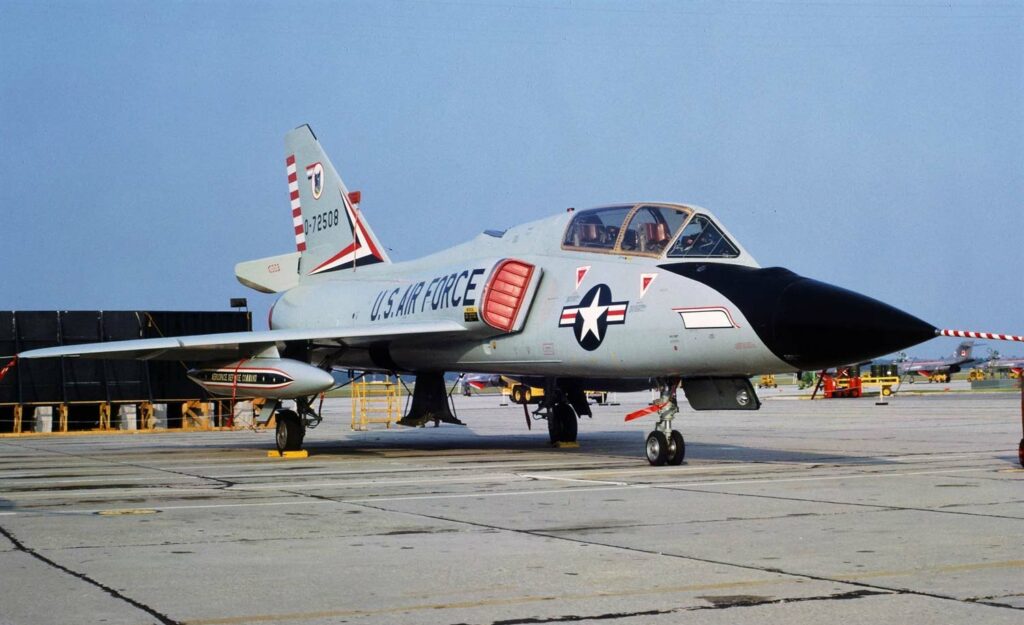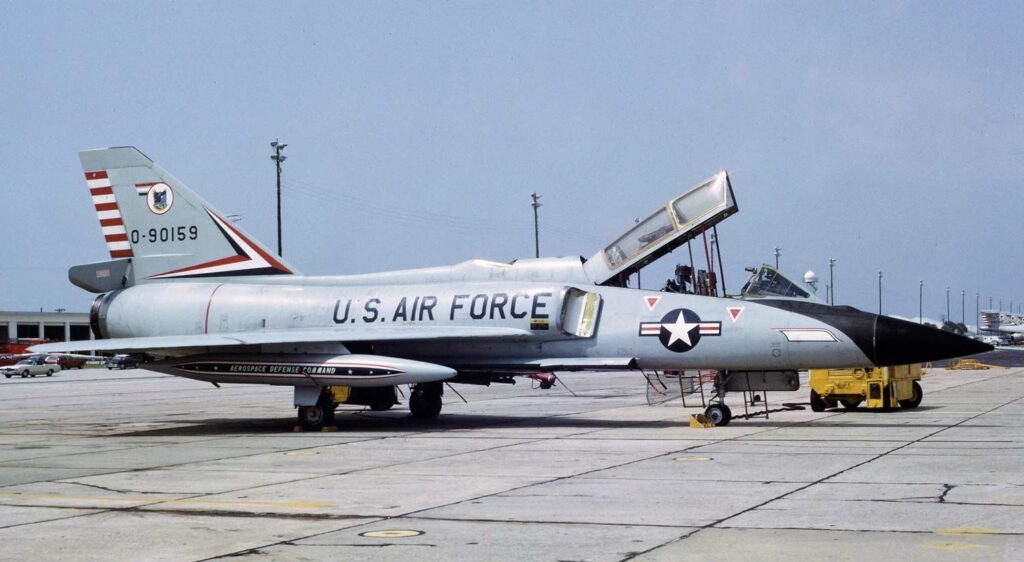The Convair F-106 Delta Dart was the ultimate USAF interceptor, known for its speed, altitude capability, and advanced avionics.
In brief
The Convair F-106 Delta Dart, a supersonic, all-weather interceptor aircraft, was developed by Convair for the United States Air Force (USAF). As the primary U.S. air defense interceptor in the late 20th century, the F-106 featured a delta wing design, was powered by a Pratt & Whitney J75-P-17 turbojet engine capable of producing 24,500 pounds of thrust with afterburner, allowing it to reach speeds of Mach 2.3. Equipped with advanced avionics for its time, including the MA-1 integrated fire control system, it could autonomously track and destroy enemy targets using its AIR-2 Genie nuclear rocket or AIM-4 Falcon missiles. The F-106 represented the pinnacle of Cold War interceptor design, balancing high-speed performance, operational altitude, and firepower.

History of the Development of the Convair F-106 Delta Dart
In the context of the Cold War, with the increasing threat of Soviet bomber fleets, the USAF identified a need for a superior air defense interceptor. The Convair F-106 Delta Dart was developed as an evolution of the F-102 Delta Dagger, intended to address the latter’s performance shortcomings. Officially entering the design phase in the late 1950s after a series of developments and redesigns from its predecessor, the F-106 first flew on December 26, 1956. Known as the “Ultimate Interceptor,” the F-106 was part of the USAF’s 1954 interceptor program aimed at creating an aircraft capable of unmatched speed, altitude, and automated weapons delivery. Although it did not receive a specific NATO nickname, the F-106 became a key component of America’s air defense strategy throughout its service life.
Design of the Convair F-106 Delta Dart
The F-106’s design featured a delta wing configuration, which provided the necessary lift and stability at the high speeds and altitudes it operated. Its length was 70 feet 9 inches, with a wingspan of 38 feet 4 inches. The aircraft’s fuselage was designed to minimize aerodynamic drag, maximizing speed and efficiency. The cockpit was equipped with a “zero-zero” ejection seat, capable of safely extracting the pilot at zero altitude and zero airspeed.
One of the most significant design aspects of the F-106 was its avionics suite, particularly the MA-1 integrated fire control system. This allowed for semi-automatic interception, in which the aircraft could essentially lock onto a target and engage it with minimal pilot input. The use of hydraulic controls and an all-moving vertical tail fin enhanced its maneuverability and response time.
Performance of the Convair F-106 Delta Dart
The F-106’s performance was exemplary for its time, with a maximum speed of Mach 2.3 (approximately 1,525 mph), a service ceiling of over 57,000 feet, and a range of 1,800 miles with external fuel tanks. Its Pratt & Whitney J75 engine was a powerhouse, enabling rapid acceleration and high-altitude flight.
When compared to other interceptors of its era, such as the Soviet MiG-21, the F-106 boasted superior speed, range, and advanced avionics, making it one of the most capable interceptors of the Cold War. Its ability to engage targets at high speeds and altitudes gave the USAF a significant strategic advantage in air defense.
Variants of the Convair F-106 Delta Dart
The F-106 saw limited variants, with the primary operational version being the F-106A. A two-seat trainer variant, the F-106B, was also produced, featuring dual controls but retaining combat capabilities. Minor modifications and upgrades were made throughout its service life, including improvements to avionics and weapons systems, but the basic design remained consistent.

Military Use and Combat of the Convair F-106 Delta Dart
The F-106 served primarily in the air defense role within the United States, tasked with intercepting Soviet bombers and reconnaissance aircraft during the Cold War. While it never saw combat, its presence and capabilities significantly contributed to deterrence. It participated in numerous exercises and was on constant alert as part of NORAD’s defense strategy. The F-106 was phased out in favor of newer technology in the 1980s, with some converted into target drones (QF-106) for missile testing.
The Convair F-106 Delta Dart stands as a testament to Cold War-era engineering and strategic military planning. With its advanced design, superior performance, and groundbreaking avionics, the F-106 secured its place in history as one of the most effective interceptors of its time. Its legacy is marked not only by its technological achievements but also by its role in maintaining the balance of air power during a critical period of global tension.
Back to the Fighter Jet section.